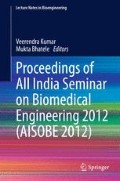Abstract
Three-dimensional finite element analysis (FEA) is widely used to generate reliable subject-specific finite element (FE) model using computed tomography (CT) data that accurately predicts information about bone morphology and tissue density. FEA provides detailed information regarding displacement, stress, and strain distributions along the entire bone. CT scan data is widely used to make realistic investigations on the mechanical behavior of bone structures. The purpose of this paper is to create anatomically accurate, three-dimensional finite element models of the right human femur of three male patients of different age groups of 17, 32, and 40 years, respectively, using CT scan data, loaded by physiologic forces, i.e., half-body weight. An average body weight of 70 kg (686.7 N) is assumed for this study, which is shared equally by the lower limbs according to the hip mechanism; hence, a load of 343.35 N (half-body weight analysis of this model will provide data unavailable at this time to orthopedic surgeons, engineers, and researchers) is applied on each right human proximal femur that affects femur during weight bearing action at different angles and to determine the total deformation, equivalent Von-Mises Stress distribution, maximum principal stress distribution, and fatigue tool throughout the whole femur and comparing the results of human orthopedics.
Access this chapter
Tax calculation will be finalised at checkout
Purchases are for personal use only
References
Gdoutos EE, Raftopoulos DD, Baril JD (1982) A critical review of the biomechanical stress analysis of the human femur. J Biomater 3:2–8
Nather A, Ong HJC, Aziz Z (2005) Bone grafts and bone substitutes: basic science and clinical applications, structure of bone. World Scientific Publishing Co. Pte. Ltd 5, Singapore
Rohlmann A, Mossner U, Bergmann G, Kolbel R (1982) Finite element analysis and experimental investigation of stresses in a femur. J Biomed Eng 4:242–246
Wille H, Rank E, Yosibash Z (2012) Prediction of the mechanical response of the femur with uncertain elastic properties. J Biomech. Accepted in Feb 2012
Grassi L, Schoileo E, Taddei F, Zani L, Juszczyk M, Cristofolini L, Viceconti M (2012) Accuracy of finite element predictions in sideways load configurations for the proximal human femur. J Biomech 45:394–399
Trabelsi N, Yosibash Z, Milgrom C (2009) Validation of subject-specific automated p-FE analysis of the proximal femur. J Biomech 42:234–241
Yosibash Z, Trabelsi N, Milgrom C (2007) Reliable simulations of the human proximal femur by high-order finite element analysis validated by experimental observations. J Biomech 40(16):3688–3699
Yosibash Z, Padan R, Joscowicz L, Milgrom C (2007) A CT-based high-order finite element analysis of the human proximal femur compared to in vitro experiments. ASME J Biomech Eng 129(3):297–309
Taylor ME, Tanner KE, Freeman MA, Yettram AL (1996) Stress and strain distribution within the intact femur: compression or bending? Med Eng Phys, Elsevier Science Ltd 18(2):122–131
Jun-hai Z, Shu-fang MA, Wue-ying WEI (2009) Finite element analysis of femur stress under bending moment and compression load. IEEE
Bitsakos C, Kerner J, Fisher I, Amis AA (2005) The effect of muscle loading on the simulation of bone remodelling in the proximal femur. J Biomech 38:133–139
Duda GN, Schneider E, Chao EYS (1997) Internal forces and moments in the femur during walking. J Biomech 30(9):933–941
Simoes JA, Vaz MA, Blatcher S, Taylor M (2000) Influence of head constraint and muscle forces on the strain distribution within the intact femur. Med Eng Phys 22:453–459
Brand RA, Crowninshield RD, Wittstock CE, Pederson DR, Clark CR, Van Krieken FM (1982) A model of lower extremity muscular anatomy. J Biomech 104:304–310
Amornsamankul S, Kaorapapong K, Wiwatanapataphee B (2010) Three-dimensional simulation of femur bone and implant in femoral canal using finite element method. Int J Math Comput Simul 4(4):171–178
Kulkarni MS, Sathe SR (2008) Experimental determination of material properties of cortical cadeveric femur bone. Trends Biomater Artif Organs 22(1):9–15
Burgers TA, Mason J, Niebur G, Ploeg HL (2008) Compressive properties of trabecular bone in the distal femur. J Biomech 4:1077–1085
Heller MO, Bergmann G, Deuretzbacher G, Claes L, Haas NP, Duda GN (2001) Influence of femoral anteversion on proximal femoral loading: measurement and simulation in four patients. Clin Biomech 16:644–649
Testi D, Viceconti M, Baruffaldi F, Cappello A (1999) Risk of fracture in elderly patients: a new predictive index based on bone mineral density and finite element analysis. Comput Methods Programs Biomed 60:23–33
Viceconti M, Bellingeri L, Cristofolini L, Toni A (1998) A comparative study on different methods of automatic mesh generation of human femurs. Med Eng Phys 20:1–10
Acknowledgments
The authors would like to thank Dr. (Mrs.) Shobha Katheria, Principal Medical Officer, Ordnance Factory Hospital, Itarsi, M.P. India, Dr Rakesh Tirkey, Assistant Professor of Medical College, Jabalpur, M.P, India, and Dr. Pushpraj Bhatele, for providing medical imaging data and supporting our work.
Conflict of Interest Statement
None of the authors have any conflict of interest to declare that could bias the presented work.
Author information
Authors and Affiliations
Corresponding author
Editor information
Editors and Affiliations
Rights and permissions
Copyright information
© 2013 Springer India
About this paper
Cite this paper
Francis, A., Nareliya, R., Kumar, V. (2013). Three-Dimensional Finite Element Analysis of Human Femur: A Comparative Study. In: Kumar, V., Bhatele, M. (eds) Proceedings of All India Seminar on Biomedical Engineering 2012 (AISOBE 2012). Lecture Notes in Bioengineering. Springer, India. https://doi.org/10.1007/978-81-322-0970-6_5
Download citation
DOI: https://doi.org/10.1007/978-81-322-0970-6_5
Published:
Publisher Name: Springer, India
Print ISBN: 978-81-322-0969-0
Online ISBN: 978-81-322-0970-6
eBook Packages: EngineeringEngineering (R0)

